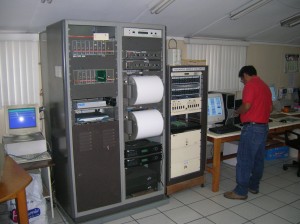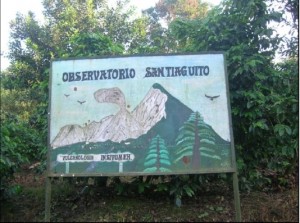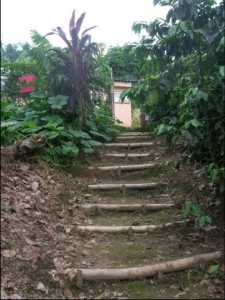1 July 2011
Report on IVM-Fund trip to Guatemala: Part 2
Posted by Jessica Ball
From April 29 – May 3, 2011, Dr. Jeff Witter of the International Volcano Monitoring Fund (IVM-Fund) made a trip to the Santiaguito Volcano Observatory (OVSAN) to deliver a set of volcano monitoring equipment. This equipment was purchased with the proceeds from a fundraising effort that I and the OVSAN personnel conceived of and that Jeff helped put into action. Jeff did a great writeup of his experiences in Guatemala, and asked that I share it with everyone who has contributed to the fundraiser (and anyone else who is wondering what that “Donate to Guatemala” button is on the top of this blog). If you’ve donated to the fundraiser, thank you, and please enjoy the results of your generosity! If you’re thinking of donating or are interested in learning more about the effort, please click on the “Donate to Guatemala” tab and visit the IVM-Fund website.
Trip report by Dr. Jeff Witter:
This trip began on April 29, 2011 when I [Jeff Witter] arrived well after dark into Guatemala City. I was thankful to see two surprisingly unscathed cardboard boxes, which contained the new computer and monitor for OVSAN, trundle towards me on the baggage claim conveyer belt. After hefting them onto a cart, I sailed through customs without any delay thanks to an official letter of introduction from INSIVUMEH. The letter itemized every piece of equipment the IVM-Fund donated to OVSAN and explained the purpose of our collaborative project. Right outside the airport, I was met by Gustavo and fellow INSIVUMEH geologist, Manuel Mota. They whisked me to a nearby hostal and we agreed to meet at 9 am the next morning to make the trip to Santiaguito volcano.
Day One: May 1, 2011
Following breakfast and our 9 am start, Gustavo and Manuel took me by INSIVUMEH headquarters. Housed in a historic building on well-manicured grounds amidst the hubub of downtown Guatemala City, INSIVUMEH is not only tasked with volcanoes and earthquakes but also weather forecasting and flood hazards ‒ which explains the large number of letters in the acronym (INSIVUMEH = Instituto Nacional de Sismología, Volcanología, Meteorología, y Hidrología). Different types of monitoring data from all of Guatemala’s volcano observatories are brought together at INSIVUMEH headquarters. For example, data from seismic monitoring stations located on the flanks of Guatemala’s three active volcanoes are sent by a radio telemetry system directly to INSIVUMEH for analysis and archival (Figures 3 & 4). Visual reports of volcanic activity (or lack thereof) are transmitted by radio three times per day from observers in the field. Daily activity reports are then written at INSIVUMEH and posted on their website (www.insivumeh.gob.gt).

INSIVUMEH seismology lab where seismic monitoring data from Guatemala's volcanoes are retrieved, archived, and analysed.
Following our departure from INSIVUMEH headquarters, we drove west from Guatemala City through the highlands to Quetzaltenango, Guatemala’s second largest city. After a lunch stop there, we headed south, fully traversing Guatemala’s volcanic mountain chain, past Cerro Quemado volcano (last erupted in 1818), the Zunil geothermal power plant, Santa Maria volcano (last erupted 1902) and on down the Samalá River valley into the humid and warm Pacific coastal lowland (Figure 5). We soon turned off the main highway and passed through a gate into Finca El Faro, a large coffee plantation where OVSAN is located. We arrived at OVSAN in late afternoon and there I met Alvaro Rojas and Julio Cornejo, the two OVSAN observers. Alvaro and Julio are stationed at the observatory full time, alternating in one-week long shifts. OVSAN is a well-outfitted observatory post with a full kitchen, running water, electricity, capacity to sleep eight, a large office/work area, and an unobstructed view of the volcano. It even has cell phone coverage thanks to a nearby telecommunications tower.

Perspective view of southwestern Guatemala showing the road route traveled during three days in the country (modified from Google Earth). Santiaguito and Fuego volcanoes are identified as well as the two observatories visited (OVSAN and OVFUEGO).
The observers, Alvaro and Julio, helped me carry all the equipment in and I began unpacking it to ensure that it was all there and arrived intact. Gustavo signed a letter of agreement that I provided which simply outlined the IVM-Fund’s expectations for the use and care of the equipment in support of the IVM-Fund’s nonprofit goals. Soon after I’d finished unpacking, I presented all the equipment to the OVSAN personnel. Gustavo then said a few words thanking the IVM-Fund, and especially all of our donors, for the generosity that made possible the donation of all the equipment. Manuel, Alvaro, Julio, and Gustavo wasted no time digging into the equipment, reading owner’s manuals, and setting up the computer.
Following a dinner of homemade chicken soup and tortillas, the guys were back in the office testing out a wireless USB modem on the new computer (Alvaro had it brought from his home). The local internet service provider ‘Claro’ gives out free USB modems to all of their paying internet customers. The wireless internet connection between OVSAN and the Claro wireless antenna on the telecommunications tower down the valley was quite good. An internet connection at OVSAN would be quite a boon to their capabilities for communication and data transfer. After discovering that a wireless internet connection was possible at OVSAN, we discussed the possibility of the IVM-Fund providing funds to pay for an OVSAN internet subscription.

From left to right: Manuel Mota, Alvaro Rojas, Julio Cornejo, and Gustavo Chigna with all the donated equipment behind.
Next time: Volcano monitoring at OVSAN






 Jessica Ball is a volcanologist at the U.S. Geological Survey, researching volcanic hydrothermal systems and stability, and doing science communication for the California Volcano Observatory. She previously worked at the Geological Society of America's Washington DC Policy Office, learning about the intersection of Earth science and legislative affairs. Her Mendenhall postdoc and PhD focused on how water affects the stability of volcanoes, and involved both field investigations and numerical modeling applications. Her blogging covers a range of topics, from her experiences in academic geosciences to science outreach and communication to her field and lab work in volcanology.
Jessica Ball is a volcanologist at the U.S. Geological Survey, researching volcanic hydrothermal systems and stability, and doing science communication for the California Volcano Observatory. She previously worked at the Geological Society of America's Washington DC Policy Office, learning about the intersection of Earth science and legislative affairs. Her Mendenhall postdoc and PhD focused on how water affects the stability of volcanoes, and involved both field investigations and numerical modeling applications. Her blogging covers a range of topics, from her experiences in academic geosciences to science outreach and communication to her field and lab work in volcanology.